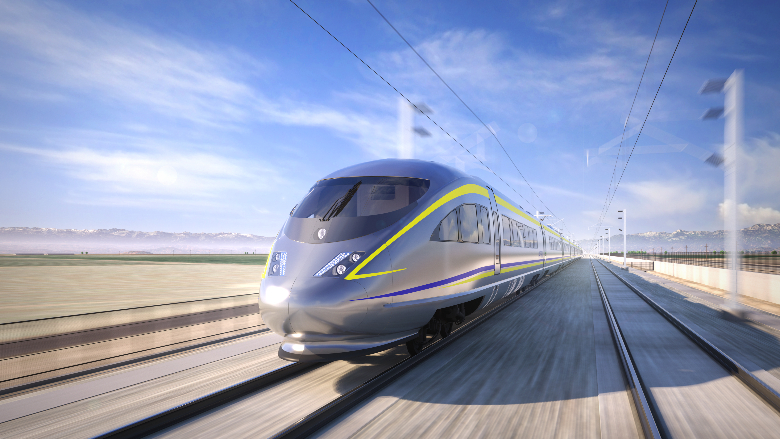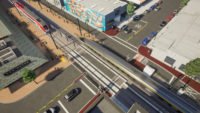Transit
California High-speed Rail Authority OKs $22.6B Palmdale-Burbank Segment

With approval of the Palmdale-Burbank segment, the California High-speed Rail Authority has completed environmental clearance for 463 line miles from San Francisco to Los Angeles.
Rendering courtesy California High-speed Rail Authority
The California High-Speed Rail Authority voted June 27 to approve a route and certify the environmental review for a $22.6-billion section of the passenger train network linking the cities of Palmdale and Burbank in Los Angeles County. With the approval, 463 miles of the planned line has been cleared from San Francisco to Los Angeles and only a relatively small portion between Los Angeles and Anaheim still awaits environmental approval.
The preferred alternative for the Palmdale-Burbank segment is a 38.3-mile route known as SR14A, including four tunneled sections totaling 27.9 miles. The tunnels would carry trains under areas including Angeles National Forest and San Gabriel Mountains National Monument to minimize impacts on communities and habitats. The use of tunnels also helps avoid tight turns and steep grades that would reduce operating speeds, said Christine Inouye, HSR Authority chief engineer of strategic delivery during the authority board meeting. This segment of the high-speed rail route would be fully grade-separated, allowing trains to reach a top speed of 220 mph.
The segment would have an operational travel time of about 17 minutes, compared to an hour-long drive, according to LaDonna DiCamillo, CHRA's Southern California regional director. The approval is “a major milestone for connecting San Francisco to Los Angeles in less than three hours,” said agency CEO Brian Kelly. “It’s also transformational for Los Angeles County, connecting Palmdale to Burbank in a way that’s never been possible before."
 Map courtesy California High-speed Rail Authority
Map courtesy California High-speed Rail AuthorityThe planned tunnel segments include two twin-bored sections running 13.2 miles and 12.4 miles respectively, according to Inouye. Two shorter tunnel segments may be built with cut-and-cover or sequential excavation. The route would also include about 1.5 miles of elevated sections, including a viaduct over the Santa Clara River and Metrolink commuter rail line.
Authority board members and public commenters raised questions about tunnel safety with seismic activity in the area. Sarah Wilson, an engineer providing tunnel expert services to the authority, said preliminary plans call for tunnels to be constructed to withstand up to 6.5 ft of movement, with tunnel lining along their full length, plus fault chambers at fault zones.
Additionally, the authority plans to use an earthquake early warning system that would automatically trigger train brakes before a quake, Wilson said. A similar system used in Japan prevented derailments during a magnitude 9.1 earthquake in 2011.
Construction of the Palmdale-Burbank segment is expected to take about seven years, following design and procurement.
In addition to being part of the larger California high-speed rail network, the segment would connect to other modes of transportation at both its ends. In the north, the station at the Palmdale Transportation Center would offer connections to bus and Metrolink commuter rail service, and potentially to the future Brightline West high-speed rail to Las Vegas via the proposed High Desert Corridor project between Palmdale and Victor Valley. In Burbank, the station would be located beside Hollywood Burbank Airport, and provide access to two Metrolink lines and other transit.
The board also voted during the meeting to approve a $131.2-million contract to the joint venture SYSTRA/TYPSA for design of track and overhead contact systems for 171 miles between Merced and Bakersfield.
Work is currently underway on 119 miles of the line in the Central Valley. Authority officials anticipate finalizing the environmental review for the Los Angeles-Anaheim segment next year.




